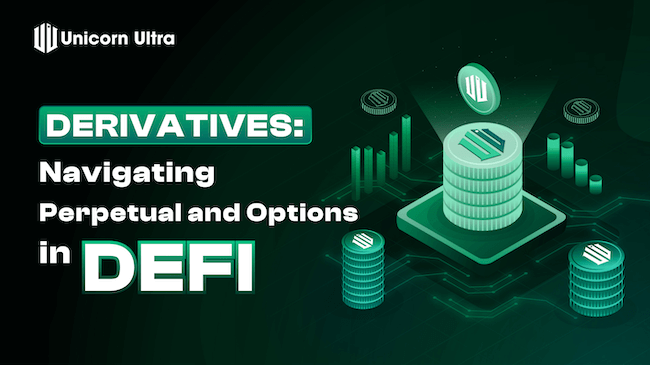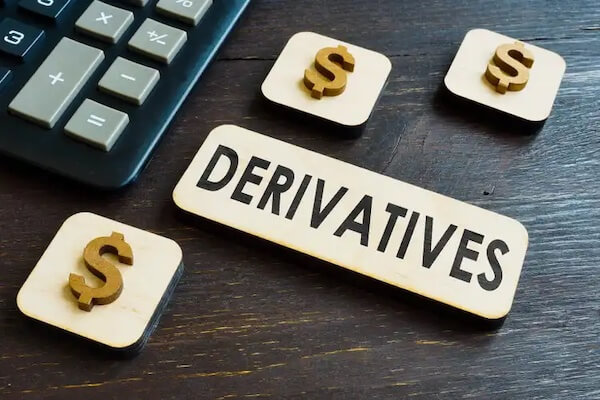Table of Contents
What are Crypto Derivatives?
Crypto derivatives are financial instruments deriving their value from an underlying crypto asset. These contracts enable traders to speculate on cryptocurrency price movements without owning the actual asset, resulting in profits or losses based on price fluctuations.
Today, specialized cryptocurrency exchanges, along with traditional financial exchanges, offer crypto derivatives. However, what's the significance behind this?

What Is the Purpose of Trading Crypto Derivatives?
Crypto derivatives serve three primary purposes: speculation, leverage trading, and hedging.
Speculation: Speculation involves predicting the future price movements of cryptocurrencies to make a profit. Traders can capitalize on the crypto market's high volatility by correctly forecasting the asset's price direction. This approach allows them to benefit from market opportunities by taking both long (buy) and short (sell) positions.
Leverage Trading: Leverage trading provides traders the ability to control a larger asset position with a relatively small capital investment. For instance, a trader may only need to commit 10% of the total value of a futures contract. On platforms like Binance, traders can leverage their positions up to 125 times the initial margin. While leverage can amplify potential profits, it also significantly increases the risk of losses.
Hedging: Hedging is a risk management strategy in which a trader takes an opposing position to an existing one to mitigate potential losses. For example, a Bitcoin holder who anticipates an increase in value may buy the asset and hold it. However, if they believe the asset's value may decrease, they can hedge their position by taking a short position on a Bitcoin futures contract, effectively offsetting potential losses.

Types of crypto derivatives
Crypto derivatives function in a manner akin to traditional derivatives. In this setup, a buyer and seller engage in a contract to exchange an underlying asset at a predetermined time and price.
Derivatives inherently lack intrinsic value; instead, they derive their worth from the underlying asset.
Now, what types of derivatives are prevalent in the cryptocurrency market? The most frequently traded varieties encompass futures, options, and perpetual contracts.
What Are Crypto Futures?
Crypto futures represent a form of derivative contract that enables two parties to agree upon a fixed price for a cryptocurrency at a predetermined future date. Upon contract maturity, the buyer is obligated to receive and purchase the asset, while the seller is obligated to deliver and sell it.
In contemporary financial and crypto markets, physical delivery of the asset doesn't always materialize with futures contracts. Instead, the profit or loss arising from the trade is typically settled in cash and credited or debited to the trader's account.
When engaging in a futures contract, traders can assume either a long or short position, indicating their outlook on the asset's future price movement.
A long position reflects a trader's belief that the underlying asset's price will increase in the future. Conversely, a short position indicates the expectation of a future price decrease.
Perpetual Futures
Perpetual futures represent a specific type of futures contract that lacks a predefined expiration date. Instead, perpetual futures contracts remain open indefinitely until the trader chooses to close the position. This means traders can maintain a perpetual futures position for an extended period, potentially benefiting from long-term price fluctuations in the underlying asset.
These futures contracts operate using a funding mechanism to keep the contract price in alignment with the spot price of the underlying asset. The disparity between the perpetual futures price and the spot price of the underlying asset determines the funding rate.
For example, if the perpetual contract price exceeds the index price, traders holding a "long" position typically pay the funding rate to offset the price differential. Conversely, if the perpetual futures contract price falls below the index price, traders with a "short" position pay the funding rate.

What Are Crypto Options?
Crypto options grant the holder the right, yet not the obligation, to buy or sell a specific quantity of a cryptocurrency at a predetermined price, known as the strike price, on or before a specified date.
However, it's important to note that trading options derivatives entails various fees:
-
Options Premium: The cost borne by the buyer for the privilege to execute a trade at a fixed price.
-
Commission: A fee levied by brokers for each options trade, which can be either a flat rate or percentage-based.
-
Contract Fees: Modest fees imposed by exchanges for each options contract, payable by both parties.
-
Exercise Fees: Charges applied by brokers when the option is exercised.
-
Margin Interest: Interest incurred on borrowed funds employed in options trading.
What Is the Impact of Derivatives Trading?
Derivatives, in a broader context, play a pivotal role in fostering a mature financial system. They empower market participants to mitigate risk, bolster liquidity, and facilitate price discovery—all of which are fundamental for the growth and evolution of financial markets.
Liquidity holds a paramount position within the cryptocurrency sector, akin to other financial markets. In essence, the absence of liquidity can exacerbate price volatility.
A dearth of liquidity can lead to wider bid-ask spreads, heightened volatility, and increased transaction costs, thereby impeding traders' ability to initiate or exit positions at favorable prices. Moreover, it can deter institutional investors, who typically necessitate a certain level of liquidity to deploy substantial capital.
Conversely, heightened liquidity attracts a broader spectrum of market participants, fostering efficient and transparent market development while mitigating the susceptibility to market manipulation.
Derivatives also furnish traders with risk-hedging mechanisms, enabling more effective portfolio management and bolstering market efficiency. Moreover, curtailing potential losses equips traders to make more informed and judicious trading decisions.
Furthermore, derivatives trading can optimize price discovery by contributing additional market data that informs price trends and market sentiment.
Advantages and Risks of Trading Crypto Derivatives
Trading derivatives presents a spectrum of advantages and disadvantages that traders need to be mindful of in order to effectively manage their trading activities.
Advantages
Trading crypto derivatives offers numerous advantages. To begin with, it tends to be more cost-effective than spot trading.
Furthermore, derivatives can serve as effective tools for traders to mitigate the risks associated with price fluctuations in underlying assets. In practical terms, employing derivatives for hedging purposes enables traders to cap losses in the event of adverse price movements.
Derivatives trading also introduces the concept of leverage, empowering traders to command larger positions with a smaller capital outlay, thus potentially magnifying their gains. Additionally, derivatives facilitate portfolio diversification, enabling traders to optimize returns and manage risks with greater precision. Engaging in derivatives trading across a diverse array of assets can mitigate individual market risks and lead to a more balanced portfolio.
Risks
Crypto derivatives carry several inherent risks, chief among them being price volatility. Derivatives trading entails speculating on the price movements of inherently volatile underlying assets. When combined with leverage trading, this risk can result in substantial losses.
Another noteworthy risk pertains to the unclear legal status of derivatives trading in certain jurisdictions. Traders must exercise caution to avoid potential legal and compliance issues, as derivatives trading is prohibited in some countries. Therefore, it is incumbent upon traders to thoroughly understand and adhere to the legal and regulatory framework governing derivatives trading in their respective countries.
Furthermore, counterparty risks are a concern in over-the-counter (OTC) derivatives transactions, as traders may not benefit from the same level of due diligence associated with trading on regulated exchanges. OTC transactions can expose traders to credit and default risks, making it imperative to exercise prudence when engaging in such trades.
Best Practices for Trading Crypto Derivatives
It is crucial to emphasize that there is no foolproof method for guaranteeing profits when trading crypto derivatives, as it inherently carries a high level of risk. However, there are strategies that traders employ to mitigate these risks and enhance their chances of success.
Common Strategies
Trading crypto derivatives is a multifaceted endeavor, and there is no universally applicable formula for success. Nonetheless, traders often employ common strategies that align with their market outlook and risk tolerance.
For instance, during a bull market, traders may opt for option contracts, specifically 'call' options, which allow them to purchase at a predetermined price. This strategy positions them to capitalize on further upward price movements. Conversely, in a bear market, 'put' options might be utilized, enabling traders to sell at a predefined price as a hedge against potential price declines.
Other tactics encompass the utilization of technical analysis to discern trends and price patterns, as well as harnessing leverage to amplify potential profits.
Risk Management
Effective risk management is paramount when engaging in crypto derivatives trading. Given the inherent volatility of cryptocurrency prices, and the fact that crypto derivatives derive their value from these underlying assets, they share in this volatility. Moreover, leverage trading compounds this risk, necessitating traders to exercise caution and employ it only if they fully comprehend its mechanics and are comfortable with the associated risks.
To mitigate risk, traders often employ specific tools such as stop-loss orders. These orders are designed to automatically liquidate a position if it reaches a predetermined price point, thereby limiting potential losses. Additionally, diversification is a commonly practiced risk management technique, wherein traders spread their holdings across various assets to prevent overexposure to any single position or asset.
Conduct Thorough Research Before Engaging in Crypto Derivatives Trading
The practice of DYOR, or 'do your own research,' is of paramount importance when it comes to successful trading in any market, including the realm of crypto derivatives. By diligently conducting your own research and analysis, you can gain a deeper understanding of the market dynamics, the assets under consideration, and the associated risks and potential rewards.
Informed decision-making within the crypto derivatives market necessitates a comprehensive research effort. Prior to proceeding, it is essential to acquaint yourself with the intricacies of crypto trading and strategies for asset segregation, should you choose to participate.
Hopefully, through this article on 'What are Crypto Derivatives' you will gain a partial understanding of the intricate characteristics and associated risks. Thank you for your interest in following us.






